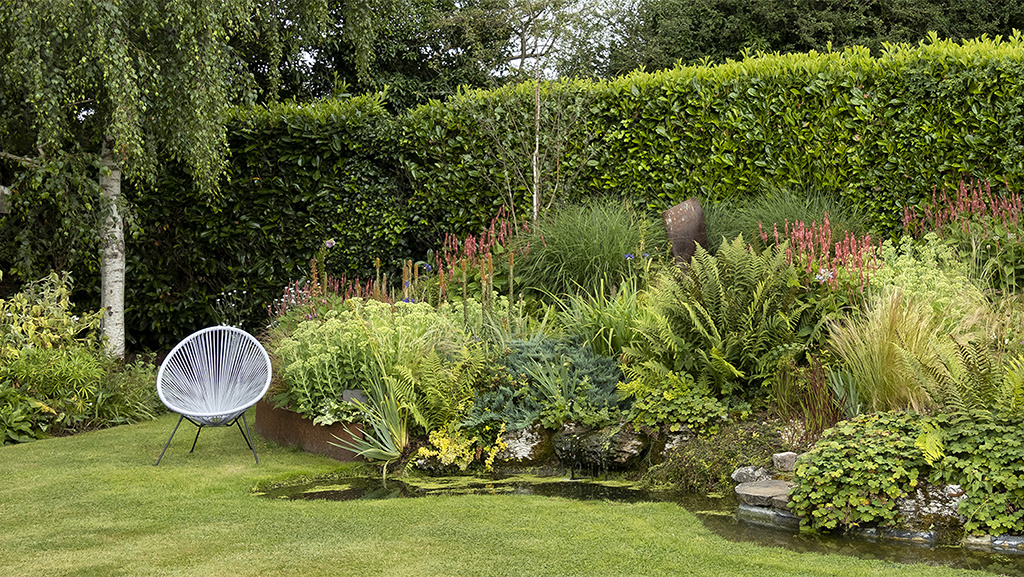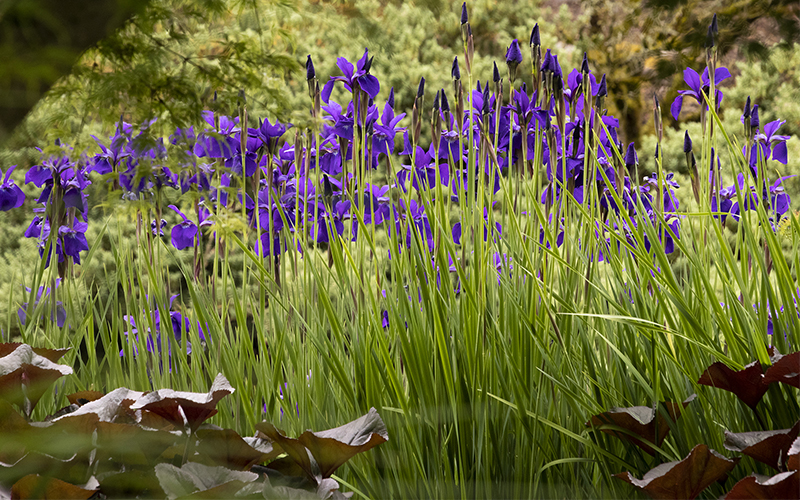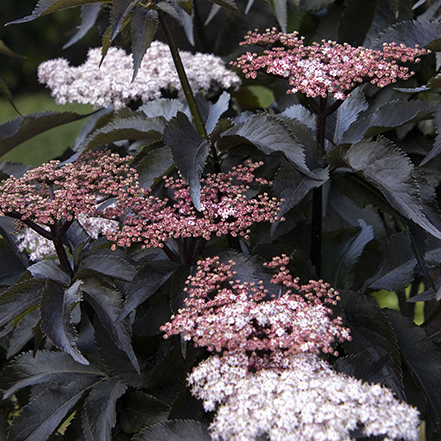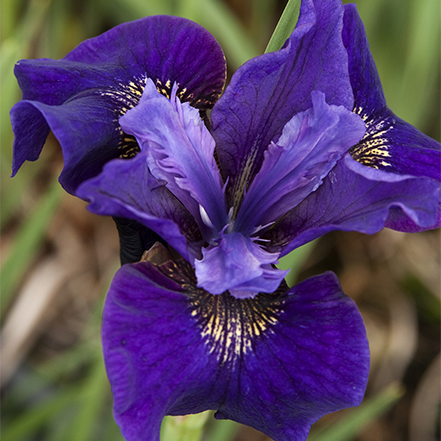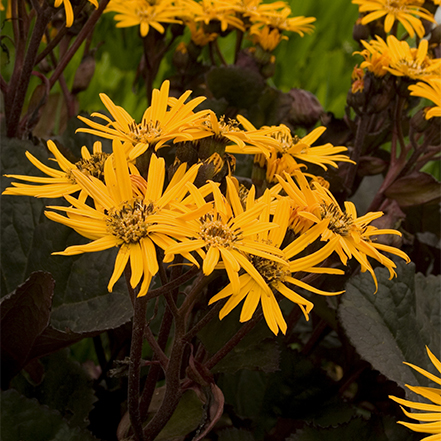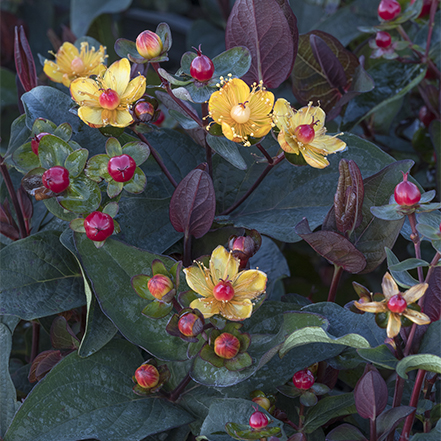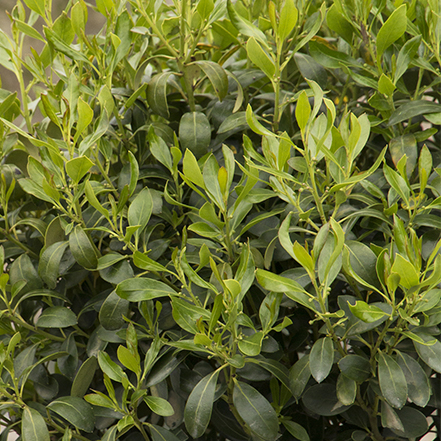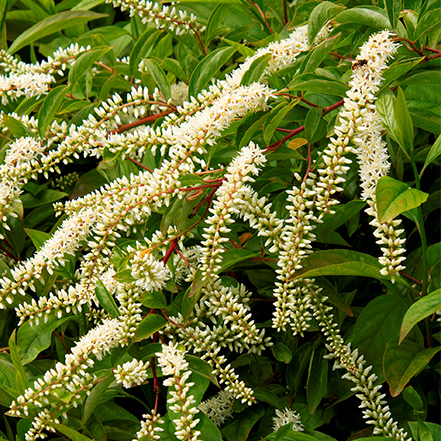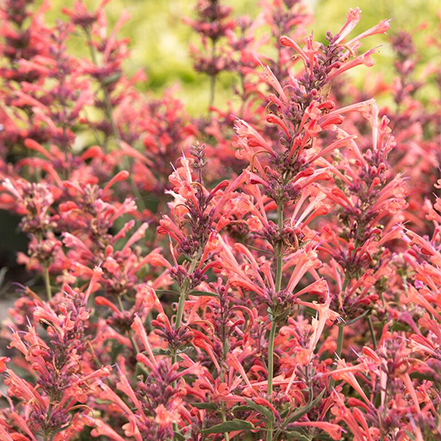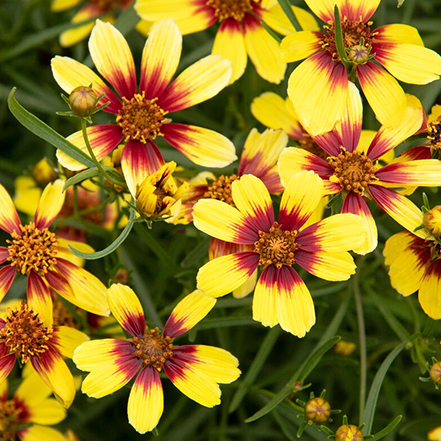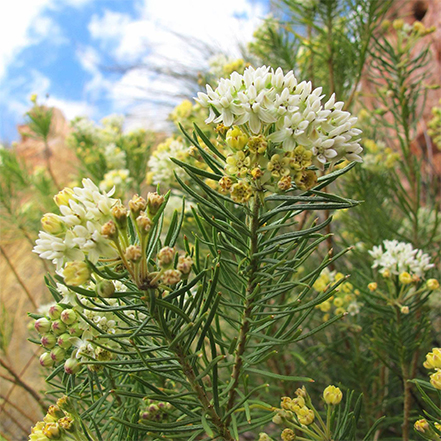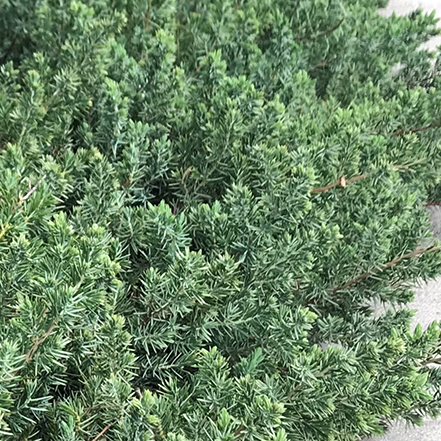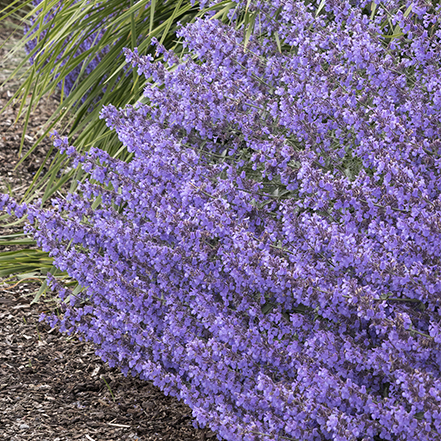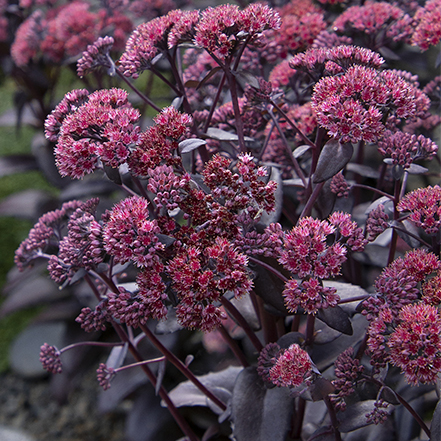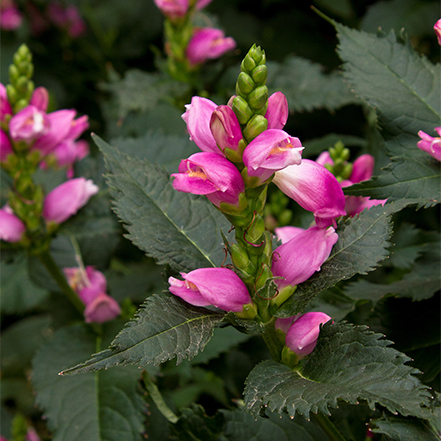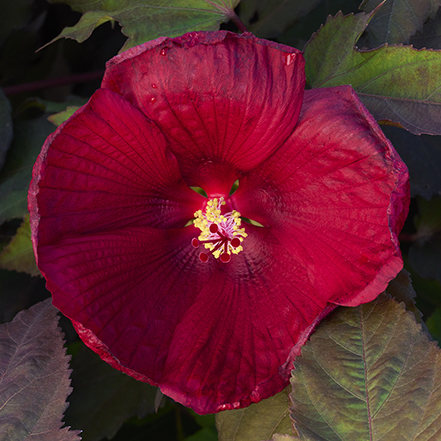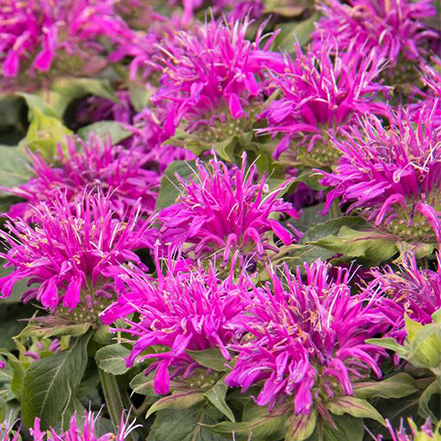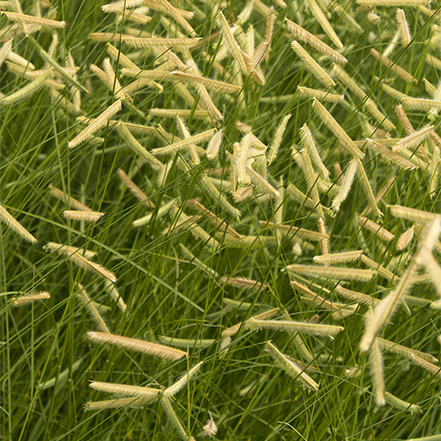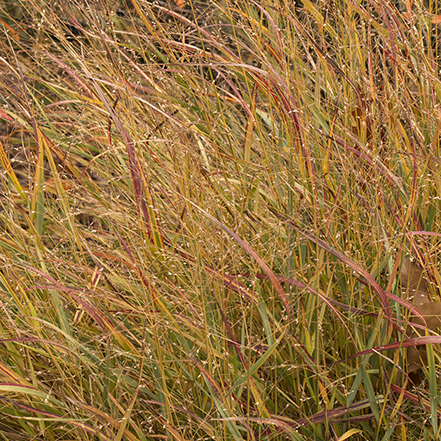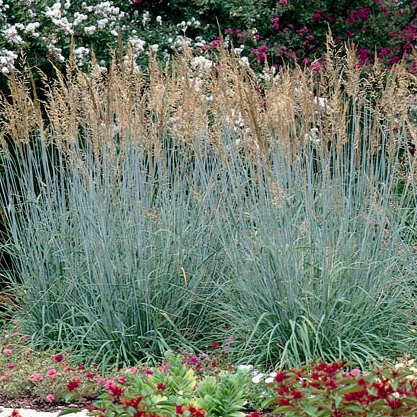Water is one of Earth’s most essential natural resources. Unfortunately, too much of the water cycle, from ocean to clouds to rain falling on the earth, has been disrupted by our built environment. Instead of getting absorbed into the soil and replenishing our groundwater supply, it stays on the surface, flowing across the land and into nearby streets and storm sewers, collecting pollutants along the way. This polluted stormwater affects the quality of our water supply and its availability.
How do we capture this resource to enhance our garden's environmental sustainability and have an attractive, low-maintenance, wildlife-friendly landscape feature? We build a rain garden.
Similar to pollinator gardens, rain gardens offer a way to garden in an ecologically responsible and beautiful way. When you learn and use the fundamentals of rain garden design, you can be part of the solution for reducing water pollution while creating a beautiful landscape to enjoy. Plus, you can increase habitat for wildlife and pollinators with your rain garden. It's a win-win!
1. What is a Rain Garden?
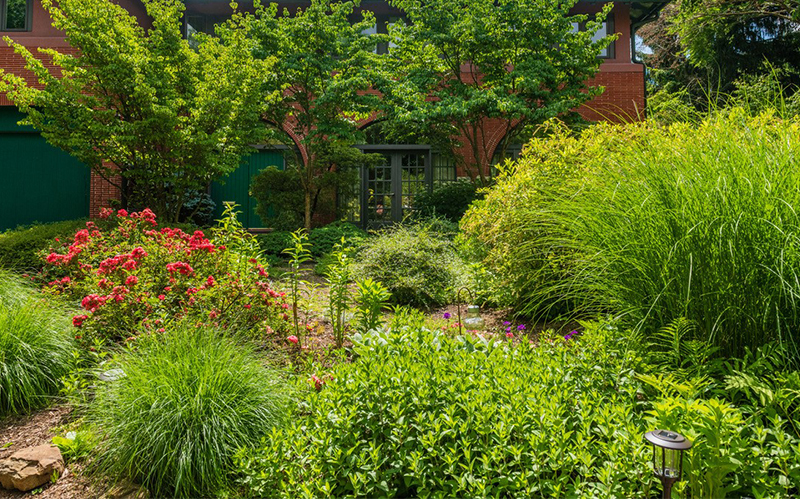
(Above) A residential rain garden replaces a front lawn. Photo by Porter Loves, courtesy of Upstream Pittsburgh
A residential rain garden is a type of green infrastructure that mimics natural processes to retain and use stormwater. It promotes water infiltration, transpiration, and harvesting throughout the landscape. It also helps restore the natural water balance in areas with scarce or plentiful rain.
Rain gardens are important for water conservation in arid and semi-arid regions where landscape irrigation can account for up to 40% of water use. In addition, they can reduce your water bill cost if you live in an area with water restrictions.
A rain garden accepts rainwater diverted from downspouts or hard surface areas such as a driveway to a planted shallow depression in the ground. This retention basin— of different shapes and dimensions—is designed to collect rain and runoff and let it slowly infiltrate the ground. It will temporarily hold stormwater runoff from impervious surfaces, such as roofs and driveways.
This stormwater runoff can include fertilizer, oil, litter, bacteria from pet waste, pesticides, and other pollutants that have toxic effects on our waterways. Rain gardens offer a solution for filtering out those pollutants.
Rain gardens are nature-based solutions that offer the following benefits:
- Improves water quality by filtering out up to 90% of nutrients and chemical pollutants.
- Allows 30% more water to soak into the ground than a conventional lawn.
- Reduces localized and flash flooding: the runoff from the roof of the average-sized home can be hundreds of thousands of gallons in a typical year.
- Replenishes the groundwater supply with clean water.
- Attracts beneficial birds, butterflies, and insects.
2. How Does a Rain Garden Work?
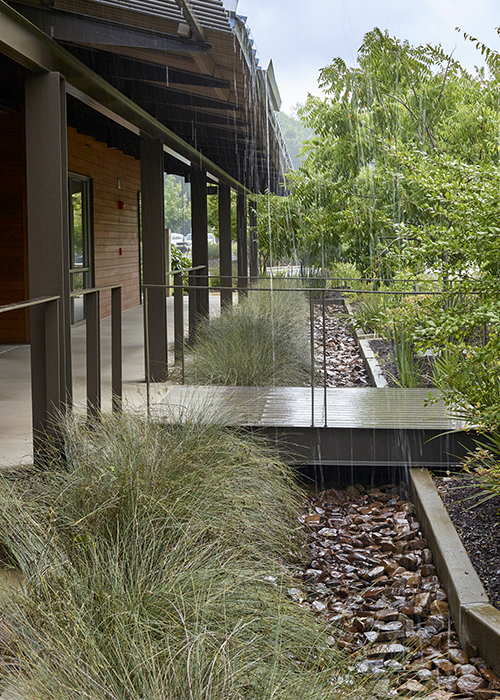
(Above) Blue oat grass is used to mitigate water runoff at Indian Springs School in Alabama. Photo by Marion Brenner, design by CARBO landscape architecture
Rain gardens typically have what is called a "rain basin," which will hold water during and after wet weather events. The rain basin is filled with an absorbent soil mix, a mulch layer, and deep-rooted plants that slow the water flow, allowing it to percolate into the ground.
When the rain garden is built on a slope, a low earthen mound called a berm is constructed on the downhill side and outside the basin to keep water in the rain garden during heavy rain. The runoff water reaches the rain garden through natural flow, shallow swales, or diverting downspouts.
The plants and soil microorganisms help cleanse stormwater of pollutants before it flows into streams and rivers.
A rain garden is usually dry and typically holds water only during and following a rainfall event. Because rain gardens will drain within 12-48 hours, mosquitoes will not breed in the water. Underdrain piping systems are sometimes installed to prevent prolonged ponding in clay soils with slow infiltration areas and seasonally high water tables.
3. Rain Garden Installation and Design Tips
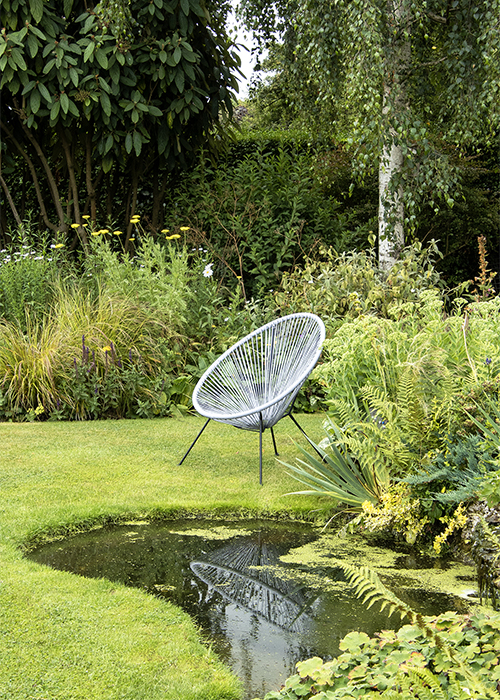
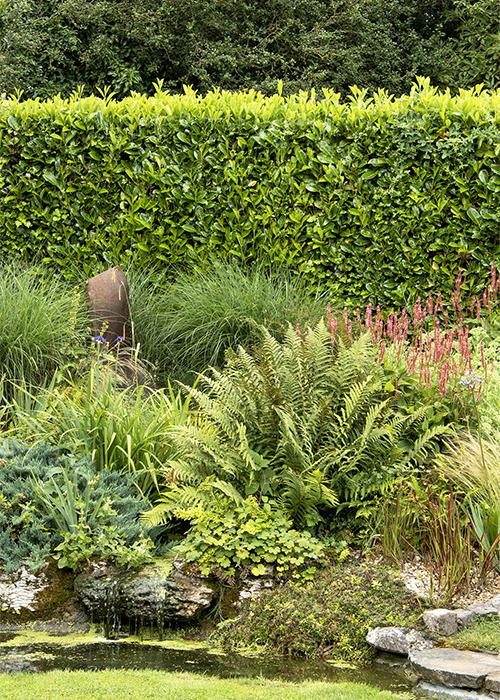
(Above) An adaptable planting of sword fern, wintercreeper, juniper, sedge, and sedum is used to mitigate runoff on the slope next to a small pond. Photos by Doreen Wynja, design by Jacky O'Leary
There are several important design considerations in building a rain garden. They consist of functional and practical must-do, in-sequence steps and aesthetics—the qualities that make for a visually appealing garden. In addition, rain gardens can vary in complexity according to how much stormwater will be absorbed.
Incorporating a rain garden in your landscape isn’t just a functional solution; it also creates opportunities for more plantings and the pleasure of observing the birds and pollinators it will bring to your garden.
Rain Garden Installation Tips
How to Determine the Ideal Location for a Rain Garden
- Look out your windows to see what views the rain garden placement will offer. Consider locating near outdoor gathering places where the beauty of the plants and the wildlife they attract can be viewed.
- Pick a spot at least ten feet downslope from the house (yours and your neighbors) to avoid creating moisture problems in the basement—fifty feet from a septic system and eight feet from a well.
- Avoid placing directly over a lateral sewer line or buried utilities. Instead, call 811 before you dig— the national phone number to access local utility location services.
- Sunny or partly-sunny locations are best, but a rain garden in the shade is possible with a careful selection of shade-tolerant woodland plants.
- Reduce the likelihood of damage to mature tree root zones by placing the garden outside the drip line—the area directly located under the outer perimeter of tree limbs.
- Although a low-lying area is a natural place to build your rain garden, ensure the site can absorb water by performing a soil percolation test. Puddled water is a sign of slow soil infiltration. Locate the rain garden upslope to intercept the runoff to eliminate an existing puddle.
How to Determine the Size and Depth of the Rain Garden
- The size of the rain garden will be determined by the amount of water runoff it will receive from your downspouts, driveway, and other hardscapes during a one-inch storm. Estimating stormwater runoff can be an intimidating, anxiety-producing hurdle for a math-phobic gardener (like me). But I will share my not-so-secret professional tip: online stormwater calculators. You can try these at home. Rain Garden Alliance; Alabama A&M; Drylands Rain Garden Calculations
- After determining the location, use a garden hose or rope to help visualize the best shape and define the edges of your rain garden. Next, remove the grass by hand-digging or renting a sod stripper if the size warrants it. Do not use an herbicide to kill the grass—it can be toxic to the newly planted rain garden plants and you.
- Your local extension office may have information to help you size a rain garden to suit rainfall patterns typical in your area.
- Use this resource to calculate the slope to determine the rain garden’s depth. Your calculations will determine the need for a simple basin rain garden or one with three different depths or zones: low and wet (Zone 1), middle and moist (Zone 2), and high and dry (Zone 3). Find plant recommendations for each zone below.
The Best Soil Mix for Your Rain Garden
Generally, rain garden soil mix contains sand, compost, original soil, and leaf or bark mulch, resulting in a neutral pH and spongy texture. On average, it should have about 5% organic matter, the portion of soil composed of plant and animal detritus that has decomposed into humus. Compost is a good source of organic matter; it reduces soil compaction, provides nutrients, and increases water filtration.
Most sources mention sand as a component of the media mix. However, caution should be used when combining sand and clay soils; unless the sand percentage is high, the mixture can result in a hard pan and poorly draining soil. Consider substituting sand with a lightweight aggregate called expanded shale if it's available in bulk in your area.
The soil type in your landscape and region soil makeup will determine the correct ratio of ingredients for good drainage. Consult with your local Cooperative Extension Office for specifics about the recommended soil mix.
Rain Garden Design Tips
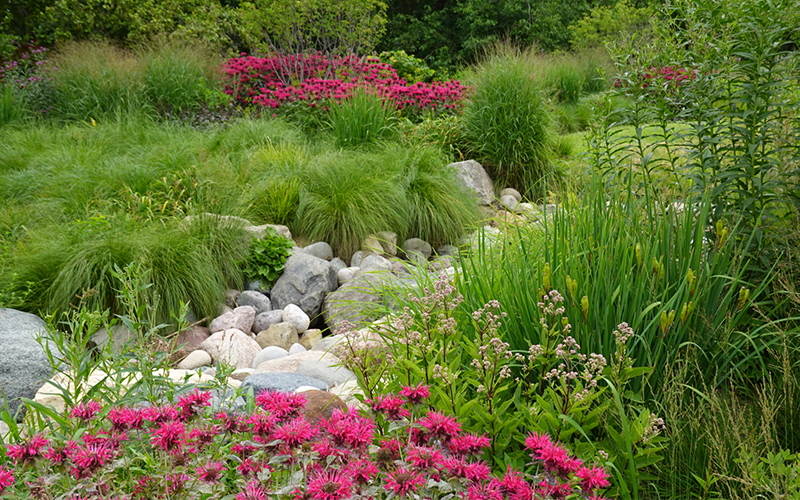
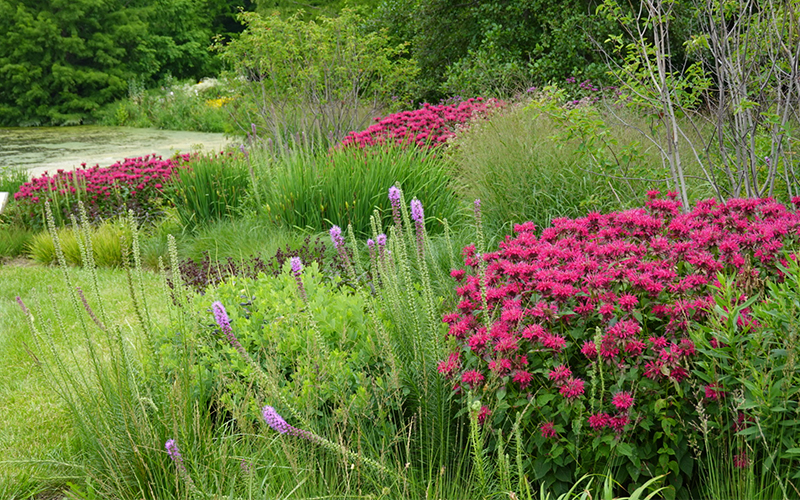
(Above) A beautiful example of a meadow rain garden that acts as a natural water filtration system, with low maintenance, adaptable plants like gayfeather, bee balm, Joe Pye weed, iris, and sedge. Design and photos by Austin Eischeid Garden Design
Your landscape should complement your home’s architectural style, and rain gardens are no exception. They can be incorporated into any garden style, formal with a well-framed, symmetrical shape or a natural teardrop-, kidney-, or round-shaped design.
- Plant densely. Allow the canopies of perennials to grow together, spacing plants about 25% closer than typically recommended. This will minimize weeds and allow roots to knit together to hold the soil in place.
- Rain gardens perform best in full or partial sun. However, plants that like shade can be added under the canopies of sun-loving plants.
- Consider the need for plant maintenance and allow room for a mulch or stone path to access plants.
- Plant in masses or drifts of 3-to-5 plants for greater visual impact. The best time to plant is in spring or early fall.
How to Monitor and Maintain the Rain Garden
Your newly planted rain garden plants may need supplemental watering during the first growing season.
Weeding is especially important in the first one to two years until the plants are well-established. After that, mature plants will out-compete most weed species. The aim is to allow the desirable plants to spread and fill in so that very little mulch can be seen.
Allow the stems and seed heads to remain through winter to feed the birds, offer wildlife cover, and provide winter interest. In the spring, when temperatures stay consistently above fifty degrees for a few days, you may safely trim last year’s plant growth that provided habitat to beneficial insects to the appropriate height the plant species dictates. Remove and compost plant debris.
You will need to check occasionally to ensure the inlet to your garden is clear so that the rainwater can flow freely. Clear away leaves, branches, or other debris.
Even if you don’t have the room to collect all of your stormwater, capturing any rainwater that would otherwise flow unimpeded into our waterways is helpful to the environment and your water bills.
(Above) Caesar's Brother Siberian Iris and Britt-Marie Crawford Ligularia are a beautiful combination for the wettest part of your rain garden. Photo by Doreen Wynja.
The first consideration is to choose plants based on your regional and hardiness zone, amount of rainfall, sunlight exposure, and soil conditions. Drought tolerance is a more significant consideration in areas where rain may be seasonal or intermittent.
Consider the following when selecting your rain garden plants:
- Deep-rooted plants often grow well in opposite site conditions, such as wet and dry soils.
- Select plant species that are deeply rooted, allowing for better water absorption of rainwater as well as soil stability.
- Consider plant texture, color, and year-round interest with plants that retain some mass when dormant, which helps to slow water in winter.
- Repeat plants or colors to create a cohesive look.
Different plants serve different functions in the rain garden:
Tall trees and shrubs deflect water and slow it down. Ornamental grasses filter and absorb water and pollutants. Find our favorite plants for a variety of rain garden functions below.
Favorite Plants for Zone 1
The lowest and wettest area of your rain garden is Zone 1, which will hold the most water for the longest time. This area needs to have plants that can tolerate flooded conditions and wet soils.
Black Tower
Elderberry
The fantastic burgundy-colored foliage on this upright shrub creates a garden spire to behold. It thrives in enriched, evenly moist, well-drained soils, and is adaptable to drier soils once established. Blackish-red berries provide seasonal forage for wildlife. Up to 8' tall, 4' wide. Zones 4-8.
Ruffled Velvet
Siberian Iris
Beardless Dutch Iris-like, with rich purple blooms that rise above the refined, slender, blue-tinged green, sword-like foliage. Use in mass plantings for a stunning effect. Thrives in moist soils, where others will not. Full sun. Up to 2' tall. Zones 4-9.
Britt-Marie
Crawford Ligularia
A mound of dramatic dark chocolate-maroon foliage contrasts boldly with its yellow-orange daisy-like flowers. A natural for all beds and borders for contrast with green and lime foliage plants. Thrives in deep, fertile, consistently moist soils. Partial to full sun. Up to 4' tall, 3' wide. Zones 4-9.
Favorite Plants for Zone 2
The middle area, or Zone 2, will hold several inches of water during and immediately after rain but will drain much sooner than Zone 1.
FloralBerry® Sangria
St. John's Wort
Clusters of golden, cup-shaped flowers on well-branched, rust-resistant plants with handsome dark green foliage accented by deep red undersides. A fuss-free deciduous shrub that's adaptable to well-drained soils. Stems of beautiful red berries are a wonderful accent in cut flower arrangements. Partial shade to full sun. Up to 3' tall and wide. Zones 5-9.
Nordic™
Inkberry
Lustrous deep green foliage covers this compact, rounded shrub. This easy-care evergreen tolerates a range of soil conditions and even moderately shaded exposures. Bears discreet black fruit if pollinated by a male. Very adaptable, tolerating light or heavy, low to high moisture, neutral to slightly acidic soils. Partial to full sun. Up to 4' tall and wide. Zones 3-9.
Henry's Garnet
Sweetspire
Brilliant red-purple fall foliage color lasts into winter to make this a standout in the landscape. Slender clusters of fragrant white flowers add to the multi-seasonal show from this award-winning plant. Prefers rich, evenly moist, well-drained soils; tolerates a wide range of soil conditions including drought and bog when established. Partial to full sun. Up to 6' tall and wide. Zones 5-9.
Favorite Plants for Zone 3
The area between the rain garden and the surrounding area is best for plants that prefer drier conditions. This planting area is similar to typical garden beds.
Kudos Coral
Dwarf Agastache
Cheerful, carefree summer color for beds, borders or containers. This prolific new compact hybrid has an impeccable habit, increased hardiness, improved disease resistance, and tolerance of wet, cold soils! Drought-tolerant in coastal regions. Full sun. Up to 20" tall, 16" wide. Zones 5-10.
Sunstar™ Gold
Coreopsis
Rich color for a sunny summer garden with this stunning new Monrovia exclusive from the Sunstar™ series. The large, red-eyed, molten gold-colored blooms smother the green, feathery, mildew-resistant foliage of this easy-care, well-behaved plant, providing a long season of vibrant color. Full sun. Up to 24" tall, 20" wide. Zones 4-9.
Monarch Magnet
Pineleaf Milkweed
This naturally occurring variation of a Southwestern native was selected due to its denser growth habit, attractive form, and thick, white, ornamental flowers that are far showier than the species type. Long, slender leaves resemble the needles of a conifer. Perfect for desert wildlife gardens or rock gardens. Partial to full sun. Up to 3' tall and wide. Zones 9-11.
Low-growing, Waterwise Plants for Rain Gardens
These drought-tolerant plants are great options for planting on a fast-draining berm or slope around a water basin.
Blue Pacific
Shore Juniper
This wonderful, low, spreading form makes a superb groundcover for tough spots. Dense blue-green foliage gives this selection a handsome appearance and is best when not pruned, but rather left in its natural form. A notably heat-tolerant variety. Up to 1' tall, spreading to 7' wide. Zones 5-9.
Junior Walker™
Catmint
A superb compact selection with finely textured, aromatic, gray-green foliage and soft, lavender flower spikes on a low, spreading habit. A sterile dwarf form of Walker's Low Catmint. An excellent and adaptable groundcover that tolerates periodic drought, when well-established. Partial to full sun. Up to 16" tall, 36" wide. Zones 5-9.
Evolution™ Chocolate
Fountain Sedum
A Monrovia exclusive that's bred for strong basal branching with compact stems that do not fall open, this delectable sedum produces a dense mound with multiple crowns of attractive, dark chocolate-colored, succulent foliage that is salted with pretty rose-pink blooms in the summer. Partial to full sun. Up to 15" tall and wide. Zones 4-9.
Deer-Resistant Perennials for Rain Gardens
While there are common plants with toxicity that deer avoid, deer diets will vary by region and sometimes by neighborhood. Select plants with known deer resistance in your area.
Hot Lips
Turtlehead
Cheerful spikes of pink snapdragon-like flowers emerge above the spreading foliage in late summer. Thrives in enriched, moist soils with part shade in cool summer climates, and full shade in warmer areas. Up to 2' tall and wide. Zones 3-8.
Head Over Heels®
Desire Hibiscus
A true show-stopper, true-red summer flowers pop against deep burgundy foliage. Quickly fills in empty spaces and forms a large, dense, shrubby form if given full sun. Provides a dramatic tropical look on a cold-hardy herbaceous perennial. Full sun. Up to 2' tall, 4' wide. Zones 4-10.
Balmy™ Lilac Bee Balm
Boldly colored, shaggy, lilac-purple flowers bloom in abundance atop a compact plant with very dark green, fragrant minty-basil-scented foliage. Resists powdery mildew better than others. Easily grown in humusy, rich, moisture-retentive soils, but highly adaptable to a variety of soils. Partial to full sun. Up to 12" tall, 10" wide. Zones 4-9.
Ornamental Grasses for Rain Gardens
Native ornamental grasses are deeply rooted, offer food for birds, and winter interest. Here are three of our favorites.
Blonde Ambition
Blue Grama Grass
This rugged, cold hardy, native grass is adaptable to many soil types and can tolerate moderate drought once the extensive root system is developed. It's the perfect choice for low-maintenance rain gardens that may also have dry conditions. Partial to full sun. Up to 3' tall and wide. Zones 4-9.
Shenandoah
Switch Grass
An adaptable native grass that prefers semi-moist to wet soils but tolerates mild drought once established. Prized for its unmatched foliage color, this handsome grass has fast-growing green leaves that emerge with red tips in spring, darken through summer, and turn a rich burgundy in fall. Partial to full sun. Up to 4' tall, 3' wide. Zones 4-9.
Sioux Blue
Indian Grass
This handsome grass has bright blue-gray foliage that turns yellow, then burnt orange in fall, with showy, bronze-yellow flower plumes. A fantastic problem-solving grass for rain gardens, erosion control or allow to naturalize for a prairie effect. Thrives in lean soils with little care. Partial to full sun. Up to 3' tall, 2' wide; blooms reach 6' tall. Zones 4-10.
Additional Resources for Growing Responsibly
- Rain garden resources: stormwaterpa.org, University of Florida, Iowa State, EPA
- Find our Backyard Habitat Guide for free here, and sign up for our newsletter to get first access to upcoming digital guides.
- Take a look at the pollinator section of the blog for a variety of stories about pollinator-friendly gardening
- Modern Meadow: A fresh take on pollinator garden design
- What to Plant to Attract Butterflies, Hummingbirds, and Bees
- Ask an Expert: Best Pollinator Plants for the Garden
- Beneficial Insects for a Healthy Garden: A Visual Guide
- Best Early-Spring Flowering Plants to Attract Pollinators
- 10 Early-Blooming, Cold-Hardy Plants for Pollinators
- Late Summer and Fall-Blooming Perennials
- Grow a Pollinator Border
- Sign up for our Grow Beautifully newsletter. You'll get more design inspiration, garden tips, how-tos, and first access to exclusive guides, webinars, and plants.




